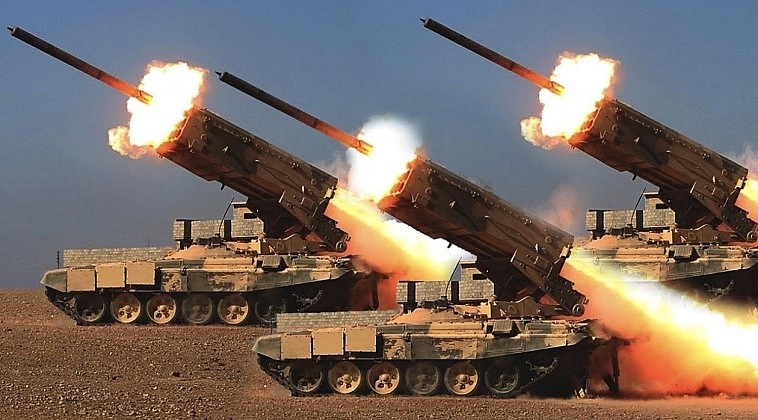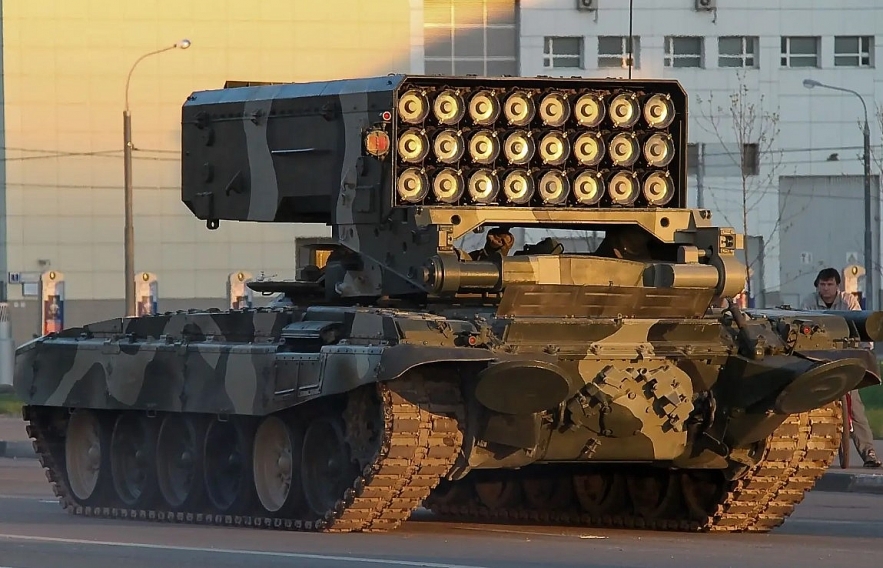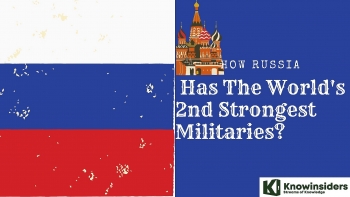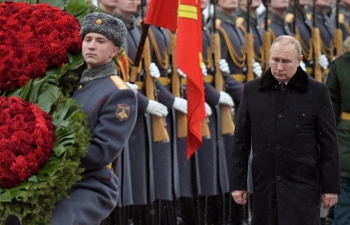TOS-1: Russia's Most Powerful Non-Nuclear Weapon in Ukraine Battlefield
 |
| Russia’s ’Flamethrower’ TOS-1A Thermobaric Rocket Systems Conduct Mass Bombardments to Support Advances in Ukraine |
| Table of Content |
The Russian Military has employed the TOS-1A 220mm rocket artillery system for large scale bombardments of Ukrainian forces in the eastern Donbas region.
Terrifying TOS-1A Thermobaric Artillery Strike Recorded In Ukraine
Video of a Russian strike in Ukraine provides a horrifying look at the TOS-1A thermobaric artillery system in action:
The system is particularly prized for its ability to neutralise infantry in well fortified positions such as those in Ukraine, and ruptures the lungs of victims in the vicinity of each impact. Each BM-1 launcher carries 24 rounds, which have been dubbed 'flamethrowers' due to their ability to clear out fortifications.
Videos have surfaced showing the terrifying detonation of what are likely rounds from Russia’s TOS-1A multiple launch rocket system (MLRS) during an attack in Ukraine.
The blasts are said to have occurred near Novomykhailivka and Lyman, both in the Donetsk region in Donbas.
In the footage, the massive shockwaves that the thermobaric rounds cause can clearly be seen, with multiple explosions occurring at once during the attack. The phenomenon you are seeing, which thermobaric weapons are especially prone to produce, is called a condensation cloud, or Wilson cloud. A sufficiently large explosion in high-humidity conditions like those that we appear to see in the video will cause a drop in density in the air around it, which in turn temporarily cools the air and causes some of the water vapor therein to condense.
This is what the the largest and most horrific war of the 21st century looks like.
What is the TOS-1: Unique Weapon
TOS-1 and its variants can do amazing damage. It is considered Russia's most powerful weapon that does not use nuclear technology.
TOS-1 operates side by side with Russian convoys and provides fire support against Ukrainian defenses. As a result, Russia's main battle tanks and armored vehicles are provided with clear directions for ease of operation. From design to functionality, the TOS-1 is capable of instilling fear on any battlefield.
This footage acts as a chilling reminder of what the TOS-1A is capable of — creating extreme heat and pressures that can do incredible harm to humans nearby.
The TOS-1 is often referred to as a heavy flamethrower, but in essence it is a multiple rocket launch system (MRLS) that uses a thermobaric rocket. Thermobaric missiles in particular and thermobaric weapons in general are weapons that use oxygen from the air to create a high-temperature explosion, causing a series of shock waves longer and larger than conventional weapons. use conventional explosives.
This Soviet-era weapon is designed to provide direct fire support to infantry and main battle tank units moving across the battlefield. Therefore, TOS-1 is often deployed along the front lines of mechanized units.
TOS-1 can destroy enemy forces in bunkers, buildings and trenches, attack fortifications and armored vehicles. It can also destroy aircraft carriers. The mechanism of action of this weapon is similar to other MLRS systems, but it can fire a variety of ammunition.
TOS-1 was born in the early 1980s and was used by the Soviet Army on the battlefield in Afghanistan. Later, Russian forces deployed the system in Chechnya. During military operations in Chechnya, it was also known as "Buratino". It is worth noting that the TOS-1 system was initially used only for testing and evaluation and was not produced in large numbers.
This weapon has a BM-1 launcher, including 30 launchers using 220mm rocket rounds. Ammunition is divided into 2 types, including warheads containing incendiary substances and warheads using thermobaric explosives - explosives used to make explosive bombs using vacuum technology, giving priority to combating anti-aircraft projects. guard like a fortress. The launch vehicle uses a modified T-72 chassis - which is the body of a Soviet main battle tank, uses a V-82-1 diesel engine, has a range of about 550km and a speed of 65km / h. TOS-1 is equipped with a modern guidance and fire control system, allowing to fire without preliminary preparation of terrain and geodesy. When operating on the battlefield, the military can deploy drones to help identify the system's targets.
| TOS-1 variants - TOS-1A: Upgrade version of TOS-1, the launch vehicle is equipped with 24 tubes in place of 30. The minimum range is 400 m and the maximum range is 6,000 m. The TOS-1A’s rockets use thermobaric, or fuel-air explosive, warheads. These use surrounding oxygen to create a high-temperature explosion. The devastating weapons, also sometimes referred to as ‘vacuum bombs,’ include a fuel container with two separate explosive charges. |
Video: Russian TOS 1A heavy flame thrower system 220mm multiple rocket launcher system:
TOS-1 Spread Fear on the Battlefield
A thermobaric missile launched from TOS-1 can burn an area the size of two football fields. Once the 200kg missile hits its target, it explodes with tremendous pressure, releasing heat up to 3,000 degrees Celsius, causing even the protective steel armor to melt. The damage to humans is greater in narrow spaces such as tunnels, trenches, bunkers ... Too high pressure can break bones, rupture eardrums, destroy internal organs. The vacuum effect can suck out the air in the victim's lungs, causing the lungs to collapse and lead to death by suffocation.
However, TOS-1 also has some disadvantages. It has a shorter range than other multiple launch systems, between 3,500m and 6,000m depending on the age of the system. The enemy can attack this system at a distance of more than 300m.
The West does not have a weapon similar to the TOS-1, but there are many other multiple launch rocket systems such as the M142 HIMARS that have been used by the US military to attack the Islamic State (IS). self-proclaimed in Iraq and recently equipped Ukraine. However, such artillery systems often use cluster or high-explosive warheads rather than thermobaric shells.
The TOS-1 in History
 |
| Tank T72 with TOS-1 - 30 barrel rocket launcher |
The TOS-1A system is a variant of the TOS-1 that dates back to the late Cold War.
During the war in Ukraine, the Russian military used the TOS-1A Solntsepek version. This version has been in service since 2001, with a range of 6,000m. This range is far enough that it can stay out of the retaliatory fire zone of enemy anti-tank weapons. The number of launch tubes of TOS-1A Solntsepek is reduced to 24 because the rocket it uses weighs 90kg, heavier than the rocket used in other versions.
The TOS-1A entered service in 2001 with an improved range and an upgraded ballistic computer, among other refinements. First used by the Russian Army in Chechnya, the complete system is mounted on a modified T-72 tank chassis and was originally designed for indirect fire support of advancing infantry units and main battle tanks. The vehicle is fitted with a rotating launch system capable of holding up to 24 unguided thermobaric rockets, which can be launched within six to 12 seconds.
Russia sold at least four TOS-1 systems to Iraq in 2014 and these systems were used by Badgdad in the fight against IS in Jurf al-Sakhar.
Before the Russian-Ukrainian conflict broke out, TOS-1 was used in the protracted war between Azerbaijan and Armenia in Nagorno-Karabakh 2020. Russia sold TOS-1A to both sides of the conflict: Azerbaijan has 18 systems, the number of which Armenia possesses is unknown. In addition, the system is also supplied to Kazakhstan and Saudi Arabia.
What are thermobaric weapons?
Thermobaric weapons are a subclass of volumetric weapons, a family that includes thermobaric weapons and fuel air explosives. They consist of a fuel container and two separate explosive charges. When a volumetric weapon is dropped or launched, the first charge detonates to disperse the fuel particles. The second charge ignites the dispersed fuel and oxygen in the air, creating a blast wave of extreme pressure and heat that has the potential to reverberate and to create a partial vacuum in an enclosed space. They are likely to cause civilian casualties due to their indiscriminate and uncontained nature.
The effects of thermobaric bombs are compounded in enclosed spaces, making them highly effective in buildings. Russia’s unanticipated struggle with urban warfare thus far might explain its reported usage. The International Criminal Court (ICC) has decided to open an investigation into potential war crimes in Ukraine, which could include the use of thermobaric weapons.
Difference Between Thermobaric Weapons and Nuclear Weapons
There is a massive difference between a thermobaric weapon and a nuclear weapon, but neither weapon is new. Fuel-air explosives were developed by the United States in the 1960s and used in Vietnam. They were also previously used by Russia in Chechnya in the 1990s, reportedly against China during a 1969 border conflict and most recently, in the conflict in Syria and possibly by the Syrian regime itself. It is believed that China and India also have these bombs. However, the United States and Russia have continued to improve them and billed them as a substitute to the vastly more destructive nuclear bombs in order to breach hardened military targets.
Russia’s largest thermobaric weapons test in 2007 had a yield of 44 tons, while the U.S. B61 tactical nuclear weapons, which are deployed in Europe, at their lowest yield are ~300 tons. For greater comparison, U.S. strategic nuclear weapons have varying yields from around 50,000 tons to 1.2 megatons. Thermobaric bombs are not in the same class by any means.
 How Strong Is The Russian Army - 2nd Strongest Militaries in the World How Strong Is The Russian Army - 2nd Strongest Militaries in the World Russia is ranked 2 of 140 out of the countries considered for the annual The Global Firepower Index (GFP) review. We will learn about the ... |
 Fact-Check: How Many Russian Soldiers Have Died in Ukraine - Updated Fact-Check: How Many Russian Soldiers Have Died in Ukraine - Updated The Ukraine - Russia War Casualties So Far - There are different information about the number of casualties of Russian soldiers in the battlefield in ... |
 'No Rival' Russian Sarmat Missile: Fly over the North and South Poles to Destroy Target 'No Rival' Russian Sarmat Missile: Fly over the North and South Poles to Destroy Target The Russian leader said that the intercontinental ballistic missile, Sarmat, would provide "food for thought" and deter anyone from thinking of retaliating against Moscow. |























